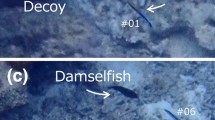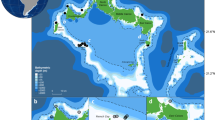Abstract
Rapana venosa is one of the most widespread species of muricid gastropod and lives on all types of substrata. Although common in Bohai Sea, relatively little is known about its ecology specially foraging behavior. We examined (1) prey selection by R. venosa when offered three prey species, Manila clams Ruditapes philippinarum, blue mussels Mytilus edulis and oysters Crassostrea gigas, (2) relative importance of various behavioral components (i.e., encounter, attack, capture and consumption) to the prey selection and (3) in detail the foraging behaviors of R. venosa in the laboratory. Predation rates, prey characteristics (shell strength, energy content per prey, handling time per prey), behavioral components (encounter probabilities, foraging time budget) and major behavioral transition frequencies were analyzed. R. venosa consumed more clams per day than mussels and oysters. Predation on clams was the most effective with a consumption rate of 0.75 clams day−1, although whelks spent only 1.23 % of their time searching for prey. In comparison, 0.54 mussels day−1 were consumed while spending 2.28 % of their time searching, and 0.29 oysters day−1 were consumed occupying 3.08 % of the time. With the preference for clams over mussels and oysters resulted from R. venosa active selection, the prey has a higher profitability. The probability of capture upon attack and consumption upon capture, reflected prey shell strength and morphology, was the two most important behavioral components to determine the prey selection for clams. Searching events took place more often when offered oysters than mussels and clams. Therefore, prey species selection by R. venosa appears to be determined by differences in prey vulnerability and accessibility, and active selection of prey with the highest profitability. Our results have implications for the provision of protective refuges for species of interest (i.e., oysters), such as in population enhancement operations and bottom aquaculture.







Similar content being viewed by others
References
Barbeau M, Scheibling RE (1994) Behavioural mechanisms of prey size selection by sea stars (Asterias vulgaris Verrill) and crabs (Cancer irroratus Say) preying on juvenile sea scallops (Placopecten magellanicus Gmelin). J Exp Mar Biol Ecol 180:103–136
Barbeau MA, Hatcher BG, Scheibling RE, Hennigar AW, Taylor LH, Risk AC (1996) Dynamics of juvenile sea scallop (Placopecten magellanicus) and their predators in bottom seeding trials in Lunenburg Bay, Nova Scotia. Can J Fish Aquat Sci 53:2494–2512
Bonsall MB, Hassell MP (1997) Apparent competition structures ecological assemblages. Nature 388:371–373
Chesson J (1978) Measuring preference in selective predation. Ecology 59:211–215
Chukhchin VD (1984) Ecology of the gastropod molluscs of the Black Sea. Acad Sc USSR Kiev Naukova Dumka 1984:175
Cooper SD, Smith DW, Bence JR (1985) Prey selection by freshwater predators with different foraging strategies. Can J Fish Aquat Sci 42(11):1720–1732
Dietl GP (2003) Coevolution of a marine gastropod predator and its dangerous bivalve prey. Biol J Linn Soc 80:409–436
Elner RW, Hughes RN (1978) Energy maximization in the diet of the short crab, Carcinus maenas. J Anim Ecol 47:103–116
Flagg PJ, Malouf RE (1983) Experimental plantings of juveniles of the hard clam Mercenaria mercenaria (Linne) in the waters of Long Island, New York. J Shellfish Res 3:19–27
Ghisotti F (1974) Rapana venosa (Valenciennes), nuova ospite Adriatica? Conchiglie, Milano 10:125–126
Halary C, Royer Y, Corlouer JP, Dao JC (1994) Effects of predation and competition on scallop, Pecten maximus, seabed cultivation in Saint Brieuc Bay: preliminary results. Proceedings on the 9th International Pectinid Workshop, Nanaimo, BC, Canada 1993:39–49
Harding JM, Mann R (1999) Observations on the biology of the veined Rapa Whelk, Rapana venosa, (Valenciennes, 1846) in the Chesapeake Bay. J Shellfish Res 18:9–17
Harding JM, Kingsley-Smith P, Savini D, Mann R (2007) Comparison of predation signatures left by Atlantic oyster drills (Urosalpinx cinerea Say, Muricidae) and veined rapa whelks (Rapana venosa Valenciennes, Muricidae) in bivalve prey. J Exp Mar Biol Ecol 352:1–11
Himmelman JH, Dutil C, Gaymer CF (2005) Foraging behavior and activity budgets of sea stars on a subtidal sediment bottom community. J Exp Mar Biol Ecol 322:153–165
Holling CS (1966) The functional response of invertebrate predators to prey density. Mem Entomol Soc Can 48:1–87
Hughes RN (1980) Optimal foraging theory in the marine context. Oceanogr Mar Bio Ann Rev 18:423–481
Hughes RN, Dunkin SDB (1984) Behavioural components of prey selection by dogwhelks, Nucella lapillus (L.), feeding on mussels, Mytilus edulis L., in the laboratory. J Exp Mar Biol Ecol 77(1):45–68
Kosyan A (2015) Predation mechanisms of Rapana venosa (Gastropoda: Muricidae) in different biotopes along the Black Sea coast. Mar Pollut Bull 102(2):265–270
Koutsoubas D, Voultsiadou-Koukoura E (1991) The occurrence of Rapana venosa (Valenciennes, 1846) (Gastropoda, Thaididae) in the Aegean Sea. Boll Malacol Milano 26:201–204
Liszka D, Underwood AJ (1990) An experimental design to determine preferences for gastropod shells by a hermit-crab. J Exp Mar Biol Ecol 137:47–62
Mann R, Harding JM (2003) Salinity tolerance of larval Rapana venosa: implications for dispersal and establishment of an invading predatory gastropod on the North American Atlantic coast. Biol Bull 204:96–103
Mistri M (2004) Effects of hypoxia on predator–prey interactions between juvenile Carcinus aestuarii and Musculista senhousia. Mar Ecol Prog Ser 275:211–217
Munari C, Mistri M (2011) Short-term hypoxia modulates Rapana venosa (Muricidae) prey preference in Adriatic lagoons. J Exp Mar Biol Ecol 407(2):166–170
Nadeau M, Barbeau MA, Brêthes JC (2009) Behavioural mechanisms of sea stars (Asterias vulgaris Verrill and Leptasterias polaris Müller) and crabs (Cancer irroratus Say and Hyas araneus Linnaeus) preying on juvenile sea scallops (Placopecten magellanicus (Gmelin)), and procedural effects of scallop tethering. J Exp Mar Biol Ecol 374(2):134–143
O’Brien WJ (1979) The predator–prey interaction of planktivorous fish and zooplankton. Am Sci 67:572–581
Pyke GH, Pulliam HR, Charnov EL (1977) Optimal foraging: a selective review of theory and tests. Q Rev Biol 52(2):137–154
Savini D, Occhipinti-Ambrogi A (2006) Consumption rates and prey preference of the invasive gastropod Rapana venosa in the Northern Adriatic Sea. Helgol Mar Res 60(2):153–159
Savini D, Harding JM, Mann R (2002) Rapa whelk Rapana venosa (Valenciennes, 1846) predation rates on hard clams Mercenaria mercenaria (Linnaeus, 1758). J Shellfish Res 21(2):777–779
Stephens DW, Krebs JR (1986) Foraging theory. Princeton University Press, Princeton
Sun Y, Wang F, Dong S (2015) A comparative study of the effect of starvation regimes on the foraging behavior of Portunus trituberculatus and Charybdis japonica. Physiol Behav 151:168–177
Sun Y, Wang F, Liu D, Dong S (2016) Behavioral mechanisms underlying the functional response of the swimming crab Portunus trituberculatus preying on the Manila clam Ruditapes philippinarum. Mar Biol 163(5):1–9
Taylor RJ (1984) Predation. Chapman and Hall, New York
Underwood AJ, Chapman MG, Crowe TP (2004) Identifying and understanding ecological preferences for habitat or prey. J Exp Mar Biol Ecol 300(1):161–187
Wong MC (2013) Green crab (Carcinus maenas (Linnaeus, 1758)) foraging on soft-shell clams (Mya arenaria Linnaeus, 1758) across seagrass complexity: behavioral mechanisms and a new habitat complexity index. J Exp Mar Biol Ecol 446:139–150
Wong MC, Barbeau MA (2003) Effects of substrate on interactions between juvenile sea scallops (Placopecten magellanicus Gmelin) and predatory sea stars (Asterias vulgaris Verrill) and rock crabs (Cancer irroratus Say). J Exp Mar Biol Ecol 287:155–178
Wong MC, Barbeau MA (2005) Prey selection and the functional response of sea stars (Asterias vulgaris Verrill) and rock crabs (Cancer irroratus Say) preying on juvenile sea scallops (Placopecten magellanicus Gmelin) and blue mussels (Mytilus edulis Linnaeus). J Exp Mar Biol Ecol 327:1–21
Wong MC, Peterson CH, Kay J (2010) Prey size selection and bottom type influence multiple predator effects in a crab–bivalve system. Mar Ecol Prog Ser 409:143–156
Zar JH (1996) Biostatistical analysis. Prentice-Hall Inc., Englewood Cliffs NJ
Acknowledgments
We thank Dr. Yunfei Sun for experiment suggestions and valuable advice in writing the article. This work was supported by the Natural Science Foundation of China (Grant No. 31572636), the Agricultural Major Application Technology Innovation Project of Shandong Province, the NSFC-Shandong Joint Fund for Marine Science Research Centers (Grant No. U1406403).
Author information
Authors and Affiliations
Corresponding authors
Ethics declarations
Conflict of interest
Authors declare that he/she has no conflict of interest.
Human and animal rights
All applicable international, national and/or institutional guidelines for the care and use of animals were followed.
Additional information
Responsible Editor: F. Bulleri.
Reviewed by Undisclosed experts.
Rights and permissions
About this article
Cite this article
Hu, N., Wang, F., Zhang, T. et al. Prey selection and foraging behavior of the whelk Rapana venosa . Mar Biol 163, 233 (2016). https://doi.org/10.1007/s00227-016-3006-8
Received:
Accepted:
Published:
DOI: https://doi.org/10.1007/s00227-016-3006-8




